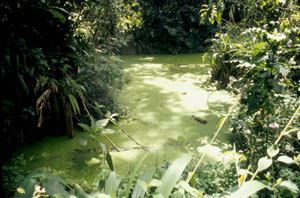|
Xenopus laevis have been kept as pets and research subjects as early as the 1950's. They are extremely hardy and long
lived. Many work on genetics and cloning have been done using this species.
Due to them being released and escaping into the wild they are illegal in many states. If you own these frogs please
DO NOT release them into the wild for any reason. If you must get rid of them, check with a local petstore or humane society.
You can also email me, i will take in frogs and adopt them out. I also know people all over the country looking for frogs
to adopt.
Keeping them in outdoor ponds is a risk for them escaping as well. They can travel short distances to other bodies of
water. Some have even been documented to survive mild freezes. They will devestate native populations of frogs and other creatures
by eating their young.
States where they are ILLEGAL
- Arizona
- California
- Kentucky
- Louisiana
- New Jersy
- North Carolina
- Oregon
- Virginia
- Hawaii
- Nevada
- Washington state
In these states it is illegal to own, transport or sell with out a permit.
(So why can Grow-A-Frog ship to all 50 states? Some things the world may never know)
How Xenopus Became Illegal
*NEW* ACF taking over Lily Pond in Southern, CA
*NEW* Pictures and Info about Lily Pond
*NEW* Invasive Species Report (ACF)
*NEW* SFexaminer reports on ACF in Lily Pond
Read an article about an African Clawed Frog discovered in a state where it is illegal
Canadian Status
So far all the information I have found states that Xenopus laevis are NOT illegal in Canada, most
importantly, New Brunswick. According to the New Brunswick Regulation 92-74, under the FISH AND WILDLIFE ACT (O.C. 92-416)
the following species listed here are NOT considered exotic and are excluded from paragraphs 38.1 (1) (a) and (b) of the FISH
AND WILDLIFE ACT.
New Brunswick Regulation 92-74: Includes the exclusion of Xenopus laevis from exotic species acts.
FISH AND WILDLIFE ACT 38.1(1)
38.1(1) Every person who,
(a) without a permit issued under paragraph
90.1(1)(a), imports into the Province exotic wildlife,
(b) without a permit issued under paragraph
90.1(1)(b), keeps exotic wildlife in captivity,
(c) fails to comply with the
terms and conditions of a permit issued under paragraph 90.1(1)(a) or (b), or
(d) without a permit issued under paragraph
90.1(1)(c) releases exotic wildlife from captivity or releases exotic wildlife from captivity contrary to the terms and conditions
of a permit issued under paragraph 90.1(1)(c)commits an offence.
**According to the New Brunswick Regulations 92-74, Xenopus and the other listed species are excluded
from (a) and (b) of section 38.1 (1) only. Still making it illegal to release Xenopus, or other species mentioned, into the
wild.**
Yes New Brunswick
residents, Xenopus laevis make perfectly legal pets. enjoy!
FISH AND WILDLIFE ACT of Canada (complete listing of all chapters, including 38.1(1))
| Man made pond in Africa |

|
| Xenopus Wittei live here |
In the wild Xenousp laevis are native to wetlands, ponds and lakes across arid/semiarid regions of southern africa. Xenopus
laevis and Xenopus muelleri occur along the western boundry of the Great African Rift. The people of the sub-saharan
are very familar with this frog. They use xenopus as a source of protein, aphrodisiac or fertility medicine in their culture.
Most of the time Xenopus are bred in captivity and then entered into the pet trade. These frogs tend to be smaller then
their wild family. They can also be harvested from the wild. Wild Xenopus are gigantic when compared to their captive
bred species.
There are 14 species of Xenopus with the Xenopus gilli being the most endangered. They are all very close in appearence
with diffrent atributes to set them apart. Look closley at your frog to make sure an X. muelleri or something else didn't
sneak in with a shipment of X. laevis.
| Trapping Wild Xenopus |

|
| this method is used to collect ACF in their wild habitat |
|

